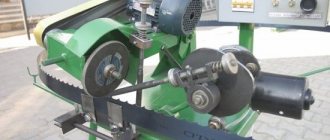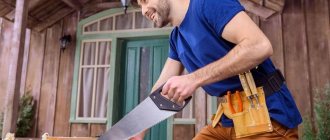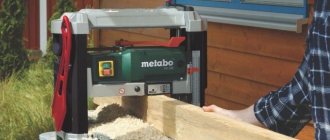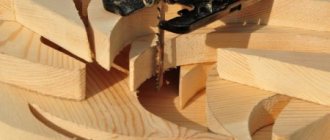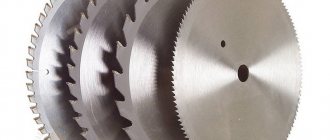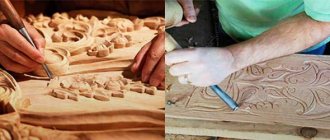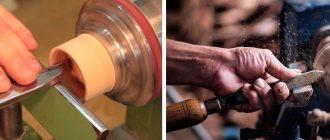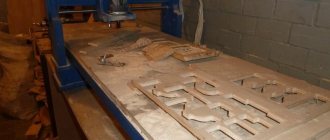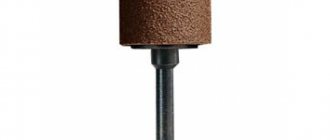How to sharpen a hacksaw
When working with wood in various ways, a tool such as a hacksaw is actively used. Over time, the cutting surface of the tool wears out, and the process of sawing wood becomes more and more difficult. Wear of the working edge is as follows:
- the pointed tops of the teeth are rounded;
- their side cutting edges become dull.
As a result, the tool loses functionality and needs to be sharpened.
How to determine when a hacksaw needs sharpening?
People with extensive experience can easily determine this moment by the sound made by the tool during operation, as well as by the change in color of the teeth. Beginners need to pay attention to the following signs:
- working with a hacksaw becomes difficult and requires great physical effort;
- it becomes very difficult to make perpendicular cuts in wood;
- it becomes difficult to hold the canvas along the line during operation, it begins to deviate in different directions;
- The hacksaw blade often jams.
Teeth setting
The setting of the saw is the deviation of the tops of the teeth from the plane of the blade. The teeth, one after another, are deflected in different directions: odd teeth in one direction, even teeth in the other.
You need to know that the quality of the wiring has a strong influence on the sawing process. Therefore, all teeth must be bent in different directions alternately by the same amount, otherwise:
- if some teeth are deflected at a greater angle than the rest, they will interfere with the movement of the tool and wear out faster;
- if the deviation is less than necessary, then the width of the cut will not allow the blade to move freely.
To set the saw teeth, a special tool is used - a setter. The simplest wiring looks like a small metal plate with a handle. It has a slot, the width of which is slightly larger than the thickness of the hacksaw blade. The teeth are set as follows:
- the saw is clamped in a vice so that the jaws of the vice end at the base of the teeth;
- then the teeth are alternately placed in the setting slot and, bending in the middle part, are moved to the side at a given angle;
- Periodically, the quality of the wiring is checked visually or using a caliper;
- To check the quality of the setting, the jaws of the vice are moved apart to the width of the setting and the saw is pulled between them (in this case, excessive bending of any tooth will not allow the blade to move freely between the jaws).
Checking the height of the hacksaw teeth
Therefore, before sharpening the hacksaw, you need to check the height of the cutting elements. This is done as follows:
- Place a sheet of paper on a flat and smooth surface and press the saw tightly against it;
- the profile is clearly imprinted on the paper, and the teeth become clearly visible;
- if higher teeth are found than the rest, then the saw is clamped in a vice and they are shortened to the desired height using a flat file.
Sharpening a hacksaw
For sharpening you will need the following tool:
- vice;
- hammer;
- calipers;
- pliers;
- emery block;
- sandpaper.
You should also have the following types of files in your arsenal:
- flat and diamond-shaped with a medium-sized notch;
- triangular file;
- triangular with velvet notch;
- needle files with notches of different calibers.
For sharpening, a special device is used that allows you to fix the blade at angles of 45 and 90 degrees. If you need to sharpen a cross saw, proceed as follows:
- the canvas is fixed at an angle of 45 degrees;
- sharpening is carried out with a triangular file with an apex angle of 60 degrees;
- the file is directed onto the hacksaw tooth at an angle of 60 to 75 degrees;
- first, with several movements of the file away from you, the left edges of the odd teeth are processed;
- After this, the hacksaw is turned over and the left edges of the even teeth are processed.
When sharpening a longitudinal hacksaw, proceed as follows:
- the canvas is fixed vertically;
- for sharpening, a rhombic file with a fine notch is used (needles can be used);
- during sharpening, the file is directed strictly parallel to the table;
- otherwise the process is similar to the previous one.
Burrs that appear on the edges of the teeth must be removed using an emery block or a file with a velvet cut.
The process of sharpening a saw for the first time is quite difficult, so it is better to carry it out in complete silence and with maximum concentration. It’s worth doing this a few times, and then things will become habitual and go “like clockwork.”
Source: https://diskmag.ru/instrument/kak-zatochit-nozhovku.html
How to Separate the Teeth of a Wood Saw
Development of tooth set
hacksaws
There is an opinion among craftsmen that 90% of all work is done by the tool, not the master. A properly made hacksaw is easy to use and significantly reduces the effort and time spent
for cutting. There are many components in the design of a hacksaw that make it easy to use.
An important place in a number of parts of preparation for work is occupied by setting teeth
hacksaws. In any hacksaw, the cutting parts are necessarily separated. An exception is essentially a hacksaw with a cross-section of the cutting blade in the shape of a trapezoid, the base being occupied by the arrangement of the teeth.
This type of saw does not require tooth alignment.
A saw with a correctly made tooth set significantly reduces the effort and time spent cutting.
The effect of tooth set on hacksaw work
The simpler it is to set the teeth, the larger the area to be sawed. If the teeth are set
is not wide enough, then during operation the upper part of the blade will heat up during friction against the edges of the cut. For this reason, the saw expands, which leads to jamming.
How to properly cut a hacksaw on wood video
- How to determine when a hacksaw needs sharpening?
- Teeth setting
- Checking the height of the hacksaw teeth
- Sharpening a hacksaw
- Purpose and structure of the saw
- Why do they split the saw?
- Wiring methods
- Sharpening
- Saw care
- Types of Band Saws
- Sharpening and setting the saw
- Hacksaw teeth. Hacksaw blade. Sharpening a hacksaw correctly
- Why does the saw, which worked easily the day before, today cut into the wood with difficulty, the plane planes the surface of the board unevenly, and the screwdriver slips off the screw slot? In the first case, the saw teeth were sharpened for longitudinal sawing, and they tried to cut wood across the grain with it, in the second, the hand pressure on the plane was incorrectly distributed, in the third, the thickness of the screwdriver blade exceeded the width of the slot. When admiring a well-made item, they say that it was made with “golden hands” - this is the highest assessment of the quality of work. Such mastery is not only achieved through extensive practice; it is unthinkable without knowledge of the specifics of using a particular tool, caring for it, and “tuning” it to perform the appropriate work. This is a kind of ABC of mastery. For example
- . If it is intended for sawing wood along the grain, the teeth are made with an inclination towards sawing (Fig. 1b). For mixed sawing, the teeth are triangular in shape (Fig. 1c), and for transverse sawing - in the shape of an isosceles triangle (Fig. 1a).
- How to set the teeth of a wood hacksaw
- How to sharpen a hacksaw
- How to sharpen and sharpen a saw correctly
When working with wood in various ways, a tool such as a hacksaw is actively used. Over time, the cutting surface of the tool wears out, and the process of sawing wood becomes more and more difficult. Wear of the working edge is as follows:
- the pointed tops of the teeth are rounded;
- their side cutting edges become dull.
As a result, the tool loses functionality and needs to be sharpened.
Purpose and structure of the saw
A hand hacksaw is used for sawing various wood materials. It is a blade with teeth at the bottom. On one side, the tool is equipped with a handle, with which the master holds it during sawing work. The quality of the handle determines the convenience and comfort of working with the saw.
The number of manufacturers of wood saws is quite large, but they all differ not only in names, but also in quality. All of them are intended for sawing wood, chipboard, logs, laminate, and tree trunks. Hacksaws are divided into such types as: classic, round, bow, as well as with a back and a reward. The thickness of the blade plays an important role when choosing a tool. After all, a thin blade can break during sawing wood, and a thick blade is quite difficult to work with.
Kinds
Like any common tool designed to perform a large number of jobs, a hacksaw for wood is classified according to several parameters.
By type of cut and purpose
Hacksaws can be designed for cross cutting, longitudinal cutting (swing) or be universal. These types differ from each other in the shape of their teeth.
The teeth of saws designed for longitudinal cutting of wood have the shape of an oblique triangle. The angle between them ranges from 45 to 60°, which allows you to cut wood in only one direction, while ensuring an accurate and even cut line. Most often they are used in the manufacture of furniture.
Hacksaws with teeth resembling an isosceles triangle are used for cross-cutting wood. Sharpening at an angle of 45-55° makes it possible to cut workpieces in both forward and reverse directions. This saw works most effectively on dry wood.
A universal hacksaw has two types of teeth - triangular and semicircular (with semicircular ones larger than triangular ones). When the saw moves forward, the long teeth set the direction, and the wider, triangular ones widen the cut, which allows sawdust and shavings to escape unhindered. The smaller the angle between these teeth, the more accurate the cut.
Depending on the purpose, hacksaws for wood are classic, circular and tenon. Classic saws are used for longitudinal or transverse cutting of wood. Circular hacksaws for wood are designed for cutting holes. Using tenon saws, elements for connecting individual parts are formed.
By tooth size
One of the main parameters of any hacksaw for wood is the size of the teeth. By size we mean pitch, that is, the distance between adjacent points. Depending on this parameter, saws may have teeth:
- small;
- average;
- large.
Hacksaws with fine teeth (from 2.0 to 2.5 mm) provide cutting of wood with high precision and are most often used for working with products of the smallest sizes.
Saws with large teeth (from 4 to 6 mm) are used for cutting logs or beams.
Hacksaws with medium tooth sizes (from 3.0 to 3.5 mm) are used when processing small parts.
There are also types of hand saws for wood with teeth arranged in groups of 6-7 pieces, separated from each other by intervals. This tool is used to process raw wood. Thanks to the existing gaps, wet wood chips do not clog the cutting channel.
Classification by design
Structurally, hacksaws for wood are:
- narrow;
- standard;
- with butt;
- with a reward;
- archery;
- folding.
Narrow hacksaws are used to cut workpieces whose thickness does not exceed 10 cm. They are also used for sawing branches in the garden, sawing out curved parts and other work. Structurally, these saws are a narrow blade with triangular teeth connected to an L-shaped handle.
The blade of a standard hacksaw (GOST 2615-84) can have any type of teeth. They are often equipped with sets of interchangeable blades designed to perform a wide variety of carpentry and joinery work.
When processing hard wood, hacksaw blades can bend greatly. Saws whose blades are equipped with a backing that acts as an additional stiffener are free from this drawback. However, its presence does not allow making a cut deeper than the width of the blade itself.
A hacksaw with a reward looks like a plane. It has two handles and is used in cases where it is necessary to make grooves or tenons. However, the depth of these elements may vary.
A bow saw is a blade stretched over a base made in the form of a large arc. It is connected to the handle using a threaded or tension connection, which allows you to use different types of blades during operation. In turn, this makes it possible to single-handedly cut workpieces with complex cutting lines.
You can also find folding hacksaws for wood on the market. They are very light and small in size when folded, which allows outdoor enthusiasts to take them with them on a hike or fishing trip. This saw has a short, pointed blade with small teeth.
Other varieties
There are other types of wood hacksaws. Among them, a garden hand saw is distinguished, equipped with a narrow blade, for the manufacture of which chromium steel is used. It is equipped with widely spaced teeth inclined towards the handle. This tool is convenient to use in cases where you have to focus on yourself while cutting.
There is a two-handed saw that is convenient for sawing large logs or felling trees. Two people should work with it.
A chain hand saw is a short chain with hardened teeth and two handles at the ends. It is compact and suitable for use on backpacking trips. You can work with it either by one person or by two people.
A modern and universal tool is an electric hacksaw, with which you can perform a large volume of various works. In some cases, it completely replaces a circular saw. When changing blades, they use it to saw not only wood, but also plastic and metal.
How to spread the teeth of a wood hacksaw? — Metals, equipment, instructions
When working with wood in various ways, a tool such as a hacksaw is actively used. Over time, the cutting surface of the tool wears out, and the process of sawing wood becomes more and more difficult. Wear of the working edge is as follows:
- the pointed tops of the teeth are rounded;
- their side cutting edges become dull.
As a result, the tool loses functionality and needs to be sharpened.
How to Separate the Teeth of a Wood Saw
Development of tooth set
hacksaws
There is an opinion among craftsmen that 90% of all work is done by the tool, not the master. A properly made hacksaw is easy to use and significantly reduces the effort and time spent
for cutting. There are many components in the design of a hacksaw that make it easy to use.
An important place in a number of parts of preparation for work is occupied by setting teeth
hacksaws. In any hacksaw, the cutting parts are necessarily separated. An exception is essentially a hacksaw with a cross-section of the cutting blade in the shape of a trapezoid, the base being occupied by the arrangement of the teeth.
This type of saw does not require tooth alignment.
A saw with a correctly made tooth set significantly reduces the effort and time spent cutting.
How to choose a hacksaw for wood.
A hacksaw is undoubtedly the most popular tool in the household. Of course, when you have an electric jigsaw, you work with a hacksaw less and less, but if there is no electricity at the dacha, then you cannot do without a hacksaw. How to choose it, what they are, which is the best, finally - read in this article.
Hacksaws are divided into 2 main types - with a hardened tooth and regular ones, made of sheet steel. Let's try to figure out which is better - with a hardened tooth or a regular one. I have something to say, since I worked for a long time with both a hardened and our usual domestic IZH production for 120 rubles.
With hardened tooth
They are black in color. As manufacturers say, such teeth will not become dull for a very long time.
I will answer - in my experience, only hacksaws with 3d teeth, which have a triangular sharpening, do not become dull. A striking example is the excellent “She-Wolf” model, which has been in service for 4 years now and still cuts wood like clockwork. Moreover, it cuts plastic panels perfectly (when they were doing repairs, they sawed the plastic not with a jigsaw, but with this hacksaw; if you cut 3 times, the plastic panel is sawn.) In general, if you don’t want to worry about sharpening, then buy one with a hardened tooth, my recommendations — hacksaw “She-Wolf”. Also from the tested brands - "Beaver" - it does not have 3D sharpening (regular triangular teeth), it cuts well, but in the long run it will definitely become dull and if you work with a hacksaw often, it will last maybe a couple of years.
Of the professional high-quality options, there are 3 blade lengths (350 mm, 400 mm and 450 mm), the tooth shape is 3-sided but tilted to the side, it cuts simply very sharply, and holds an edge for a long time. Here she is.
According to customer reviews (some are engaged in processing wood and lumber and use a hacksaw to the maximum), this saw is the best. Maximum cutting quality and speed. Therefore, if you have the opportunity to spend 300-500 rubles, take Kraftul, you won’t go wrong.
The usual good options
For those who work very often and a lot with a hacksaw. Steel cuts well provided the teeth are well sharpened and set apart. As a rule, when you first buy a saw, you can immediately work with it, but those who fumble around immediately spread the teeth even further and sharpen them with a triangular file. The most important difference from the hardened one is that it is possible to sharpen the teeth when they become dull. If the hardened one becomes dull, you can throw it away. Therefore, an ordinary hacksaw is the choice of those who work often and a lot. With care and timely sharpening and setting, it will last for many years.
Another note: What is a good carpenter's ax?
Among the manufacturers, we note hacksaws produced by IZH (our domestic ones). The bright orange handle will immediately catch your eye. Moreover, the bright color of the handle will not allow the hacksaw to get lost in the grass or anywhere else. The dimensions of the blade are different, both in width and in length and tooth size.
500 mm tooth 6.5 mm (equilateral triangle) 500 mm * 8 mm (for sawing thick boards and logs) 400 mm * 5 mm (optimal for household use) 400 mm * 4 mm (for “clean” sawing - smooth and clean res)
There is also a universal one with replaceable blades on sale, length 300 mm and 3 blades (3 types of teeth). Photo below...
Also about - I myself have such a saw on my farm. When I bought it, it was simply fantastic, it cuts like clockwork, but a month later it became dull and had to be sharpened, after which it cut like clockwork again. I really like it, the tooth is 5 mm large - it cuts quickly, the length is 450 mm.
Well, I had a chance to try “Kremlevka”. I fell for the advertisement, bought it, and it turned out that it wasn’t as cool as they said. The downside is that the handle is very weak, the teeth are not set apart at all, it constantly jams even in a thin board. But try to dissolve the Kremlin’s tooth and you’ll get tired of it.
So if you choose a good file, you will work from time to time and it is important that the price is low - then take the “Wolf” with a hardened tooth, this will serve you for many years. Well, if you work often, then it’s better to take a non-hardened one - you can sharpen it and spread the teeth further apart. With proper care, this will also last a very long time. Enjoy the shopping.
How to set the teeth of a wood hacksaw
A saw is often used to process wooden blanks and change length and shape. This tool is represented by a combination of a working part and a handle. In this case, the working part is represented by a metal plate with cutting elements, which are located in a certain sequence relative to each other. Only with proper and timely maintenance can the possibility of product wear be eliminated. An example is the setting of the teeth, which is performed from time to time to ensure smooth movement of the tool along the resulting cut.
Device for setting saw teeth
Setting the cutting edge in different directions eliminates the possibility of the blade getting stuck during operation. An example is the case when, when cutting a thick log, the blade cannot be moved and removed. Also, the saw can jam due to the heating of the metal and its expansion, the hot part can heat the resin and turn it into a kind of glue.
You should use a tool for setting the teeth of hacksaws in order to avoid such problems. Do not forget that mistakes made during work can lead to even bigger problems. The procedure in question can be carried out using the following tools:
- There are special mechanisms. They allow you to manually shift individual elements relative to each other. It is worth considering that this version is manufactured for specific products.
- Mechanical wiring is most often used. They allow you to change the angle of position, as well as their width. This tool is characterized by higher efficiency in use.
- The improvised version is not intended for working with a hacksaw on wood, but can be used for this purpose. An example is pliers and other improvised tools found in almost every workshop.
If sawing is carried out frequently, then experts recommend purchasing a special device that allows you to quickly set the required angle.
How to properly spread the teeth of a hacksaw?
A fairly common question is how to set the teeth of a hacksaw on wood. If they are offset in one line, the cut is narrow and the working part gets stuck in one place. In this case, the metal quickly heats up, due to which it begins to expand. In order to set the teeth efficiently, it is recommended to use special mechanisms. Recommendations for the work being carried out are as follows:
- The saw is clamped in a vice for secure fixation. You can eliminate the possibility of damage to the working part by using plywood as a lining.
- All cutting elements are bent one at a time to the recommended angle.
When considering how to make a cut on a hacksaw, we note that several elements deflected at a larger angle can make sawing more difficult.
Requirements for hacksaw wiring
In order to carry out the wiring correctly, you need to pay attention to the basic requirements. They are as follows:
- The procedure is carried out while fixing the instrument.
- The required angle must be strictly maintained; deviation from it causes a decrease in the quality of the resulting cut.
- At the time of work, care is taken to ensure that the surface is free of defects.
It is worth considering that too high an indicator causes an increase in the cutting width, which reduces the productivity indicator. That is why a special device must be used to set the teeth.
Setting teeth at home
Today, at home, you almost never find special devices designed for servicing hacksaws for metal. However, even in its absence, it is possible to carry out the work with improvised tools. The recommendations are as follows:
- To begin with, the hacksaw must be securely fastened in a vice. This is due to the fact that bending requires a lot of force.
- You can bend it using pliers. In order to maintain the correct angle, you must first create a template.
- You cannot skip more than one element of the cutting edge. In this case, attention should be paid to the condition of the surface, since identified defects indicate that the wood hacksaw cannot be used.
Even at home, in the absence of a special mechanism, you can carry out the correct wiring and significantly extend the service life of the wood saw. In this case, it is important to maintain the required angle, since a cut that is too wide causes a significant decrease in productivity, while a cut that is too narrow leads to heating of the working part and its severe wear.
Handle shape
An important structural element of the tool is the handle. The handle of hand hacksaws can also be classified according to a fairly large number of characteristics. The features include the following points:
- Various materials are used in production. In most cases, the handle is plastic, since this material is lightweight and can withstand moisture. Also, metal and wood can be used in the manufacture of the handle.
- The shape is also significantly different. In some cases it is represented by a simple handle, in others by an element with a hole.
It is important that the handle is comfortable to use, otherwise prolonged sawing can create a lot of difficulties. In addition, it must be securely attached to the working part, since otherwise the applied load will damage the connection.
Device for setting hacksaw teeth - HelpLaw
A hand saw, despite the variety of electric tools, still remains one of the most popular devices when working with wood.
It is characterized by its low cost, compactness and immediate readiness for use. The use of a hacksaw is especially important when there is no source of electricity.
In order for sawing to be done quickly and correctly, you need to know how to sharpen a hacksaw on wood at home if you don’t have a sharpening machine or a grinder.
Signs that your saw is dull
Given the fact that a hacksaw is subjected to constant loads during use, its teeth become dull over time. The efficiency of working with a blunt instrument is noticeably less. In addition, you should not use such a hacksaw for the following reasons:
- productivity decreases. When sawing wood, more of the craftsman's effort and time are spent;
- the accuracy of work performance deteriorates. It is almost impossible to cut wood smoothly and accurately with dull teeth. It is especially difficult to work with such a saw in the garden;
- danger of using a hacksaw. During operation, the tool will get stuck, move off the cutting line, or jam, which increases the likelihood of injury.
The hacksaw needs to be sharpened urgently if a characteristic dull sound appears, the tips of the teeth are rounded, and it is impossible to cut wood. If the tool has become difficult to work with, then it is better to stop sawing, inspect it and begin to resolve the issue of sharpening.
Basic Rules
When sharpening a wood saw with your own hands, you need concentration, a good eye, and skills in working with a file. Despite the apparent complexity of the process, if you follow the recommendations, this manipulation can be done quite simply, although not quickly. To sharpen a hacksaw at home, you need to spend an hour or two, but you can do it faster if you get good at it.
Hacksaws are also sharpened with a grinder, but many craftsmen have a negative attitude towards this method. Firstly, it is unsafe, and secondly, you can damage the incisors more than sharpen them.
Preparation
The blade must be securely fixed in a vice. You can also sharpen on your knees or a stool, but holding the hacksaw is so inconvenient. The place where sharpening is carried out should be well lit; for safety reasons, gloves should be worn. Nothing extraneous, such as a TV, should distract from work.
To restore the performance characteristics of carpentry tools, it is necessary to use only a high-quality file. Usually a triangular file is used, and for the small teeth of a garden hacksaw a special tetrahedral file is provided.
The edges of the incisors must be cleaned with a needle file or a file that has a fine velvet notch. If you have to use a used file, then first clean it with a steel brush.
A small layer of coating is ground off the incisors. During their processing, the file should not slip, but cling to them well. If this does not happen, then the file is not suitable for processing or the blade cutters are overheated. For sharpening, you should take another tool. If the repeated attempt is unsuccessful, it is recommended to change the hacksaw.
Sharpening
To sharpen a hacksaw on wood with a file correctly, hold its handle with your right hand and hold the end with your left. The tool is directed at the teeth of the blade at an angle (like a bevel). The pressure should be uniform, smooth and only in a certain direction (usually away from you).
If possible, it is advisable to ensure that the removed layer of metal is of the same thickness. To do this, it is recommended to move the tool an equal number of times and with equal pressure. This way you can maintain the height, steps and angles of the teeth after processing.
It is necessary to remove burrs that appear on the edges of the tooth with a damp whetstone or with a file with a velvet notch. If left, they will reduce the sharpness of the teeth and chip when cutting wood materials, which will worsen the quality of the manipulations performed.
When sharpening is finished, check the sharpness of the teeth by sawing a piece of wood. If, when inspecting the saw blade, the cutters do not shine, then all actions were done effectively and the hacksaw is ready for use.
Sharpening hacksaw teeth for crosscutting
To bring back the sharpness of crosscutting tools, it is more effective to use a triangular file with a personal cut and an angle of 60°.
After clamping the blunt hacksaw in the setting, begin processing the left edge on the first cutter. It is recommended to fix the blade at an angle of 45-50° relative to the working plane.
The file is installed parallel to the surface of the work table at an angle of 60-75 °.
Restorative manipulation of blunt incisors is carried out in several passes. The first step is to sharpen the left edges of the odd cutters, and then the right edges.
After passing the odd-numbered cutters, the tool is deployed in the sharpening device to begin processing the even-numbered teeth that are in the far row.
When working with crosscut saws, it is important to control the sharpness of the cutting edges.


